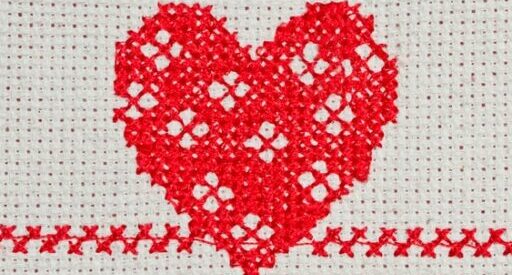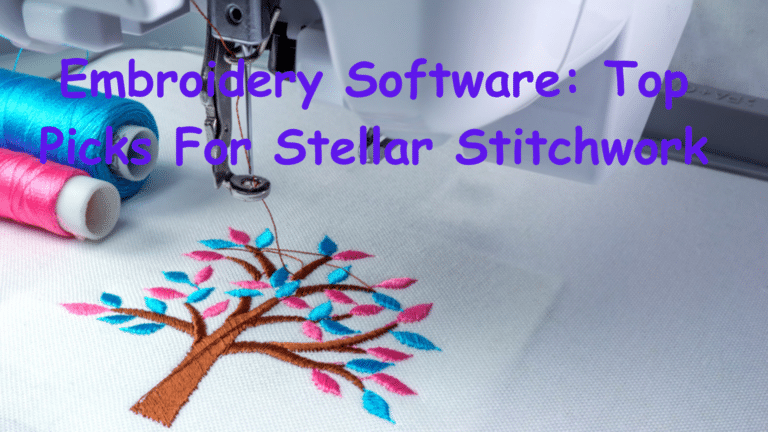Clothing Embroidery Machine: Top Picks for Exceptional Designs
Embroidery can transform the most basic garment into a work of art. With the advent of clothing embroidery machines, this craft is more accessible than ever. Whether you’re a beginner looking to personalize your wardrobe or an entrepreneur aiming to start a bespoke clothing line, an embroidery machine can be your gateway into a world of creative possibilities.
These machines are designed to handle intricate designs and a variety of fabrics, making them a valuable addition for anyone interested in textile art.
As you embark on your journey, understanding how embroidery machines work and what they can do is crucial.
Embroidery machines come with a spectrum of features, from basic models suitable for hobbyists to advanced machines for professional quality output.
Knowing the basics, from threading the machine to selecting the right stitch pattern, sets the foundation for successful projects.

It’s also worth mentioning the importance of maintaining your machine, as regular cleaning and servicing can prevent most performance issues.
Table of Contents
- 1 Frequently Asked Questions
- 1.1 What are the top-rated embroidery machines for home businesses?
- 1.2 How much does a high-quality clothing embroidery machine typically cost?
- 1.3 Can owning a commercial embroidery machine be profitable for a small business?
- 1.4 What features should I consider when purchasing a computerized embroidery machine?
- 1.5 Which brand offers the best durability in embroidery machines for professional use?
- 1.6 How do I decide between a single-head and multi-head embroidery machine for commercial purposes?
- 2 Understanding Embroidery Machines
- 3 Starting with the Basics
- 4 Working with Different Materials and Designs
- 5 Embroidery Machine Maintenance and Troubleshooting
- 6 Choosing the Right Machine for Your Budget
Key Takeaways
- Embroidery machines offer a unique way to customize clothing, suitable for both beginners and experts.
- Starting with the basics and regularly maintaining your machine ensures longevity and quality craftsmanship.
- It’s important to choose an embroidery machine that aligns with your skill level and budget to maximize its potential.
Frequently Asked Questions
Embroidery machines are a game changer for your creative enterprise. Snap up the best investment for your needs with this quick guide to the most commonly asked questions.
What are the top-rated embroidery machines for home businesses?
For home businesses, the Brother PE800 and Janome Memory Craft 500E score top marks for their versatility and ease of use. They’re your go-to workhorses for tackling diverse projects with professional finesse.
How much does a high-quality clothing embroidery machine typically cost?
Prepare to invest anywhere between $500 for a basic model to upwards of $4,000 for a high-end machine. High-quality embroidery machines come with a heftier price tag but offer superior stability, speed, and intricacy.
Can owning a commercial embroidery machine be profitable for a small business?
Absolutely. With a commercial embroidery machine, you can offer personalized products, which can command higher prices. Streamline your production process and you could see a significant return on investment.
What features should I consider when purchasing a computerized embroidery machine?
Opt for a computerized embroidery machine with a generous stitching field, intuitive software, and a good selection of built-in designs and fonts. Connectivity and editing capabilities are also key for custom projects.
Which brand offers the best durability in embroidery machines for professional use?
Brands like Tajima and Melco are renowned for their durability in commercial settings, consistently producing machines that can withstand the rigors of high-volume production.
How do I decide between a single-head and multi-head embroidery machine for commercial purposes?
Gauge your volume. If you’re doing bespoke items or small runs, a single-head machine offers versatility. For bulk orders and streamlined production, a multi-head unit can be a time-saving powerhouse.
Understanding Embroidery Machines
Embroidery can transform the mundane into the magnificent, and the right machine is your gateway. Let’s dissect the essentials.
Types of Embroidery Machines
You’ll find two main characters in the embroidery machine saga: embroidery only machines and sewing and embroidery machines.
If your heart is set on embellishing, an embroidery-only machine is your faithful ally, specializing in patterns without the sewing fluff.
On the other flank, you have the versatile heroes – the sewing and embroidery machines, perfect for those who can’t commit to just one craft.
In the realms of sophistication and capability, we come across multi-needle embroidery machines.
These are the workhorses with multiple needles (usually four to ten), each can be threaded with a different color, which means less manual thread changing – a time saver for sure.
The four-needle embroidery machine is a great leap from your single-needle comrade, but if you’re after productivity and complexity, consider a machine that’s even more multi-needled.
Key Features to Consider
Embroidery machines are laden with features that can make any fabric aficionado swoon. Here’s what to eye for:
- Hoop Size: The bigger the hoop, the larger the embroidery designs you can stitch in a single go.
- Embroidery Field: Ensure it’s large enough to accommodate your most ambitious designs.
- Design Editing: Some machines come with built-in software allowing you to customize designs directly on the machine’s screen – a big plus.
Embroidery machines come in various levels of computerization, with high-end models offering touchscreen displays and vast libraries of pre-installed designs.
Connectivity is key; looking for a machine that can connect to a computer or has a USB port allows you to download and stitch endless designs.
Embroidery Machine for Beginners
If you’re dipping your toes into the embroidery waters, you need a beginner-friendly sidekick.
Look for an embroidery machine that’s easy to thread, has straightforward controls, and doesn’t overwhelm with excessive features.
A humble machine with a modest price tag and a helpful tutorial or two will have you stitching confidently without any tantrums.
Starting with the Basics
Embroidery can transform the most basic piece of fabric into a tapestry brimming with character. Before you dive needle-first into this craft, understanding your tools and setup is essential for a seamless experience.
Choosing Your First Embroidery Machine
When you’re standing in the store or scrolling through pages of machines, you want to zero in on key features that fit your embroidery aspirations.
Think about the size of the embroidery area—don’t cramp your style with something too small for your grand plans. Ensure it supports a variety of hoop sizes to keep your options open.
Your first machine—an investment, really—should handle a myriad of designs and offer adjustable thread tension for different thread types and weights.
| Feature | Why It Matters |
|---|---|
| Embroidery Area | Determines the size of your designs. |
| Hoop Size | Affects the fabric tension and the accuracy of your stitches. |
| Thread Tension | Ensures your stitches are even and not puckered. |
Setting Up Your Embroidery Machine
You’ve unboxed your new treasure; now let’s get it humming.
First off, stick with a needle that’s just right for your thread and fabric type—trust me, it makes a difference. It should slip through the fabric without resistance or drama.
Next, hooping can be tricky, but once you master the tension, it’s like riding a bike. Make sure the fabric is taut and secure in your embroidery hoop—imagine a trampoline’s tension.
Finally, play around with stabilizers; they’re the unsung heroes that keep the fabric from dancing under the needle. Select one that complements your fabric choice and watch it work wonders.
Working with Different Materials and Designs
Embroidery can bring out the personality in your fabrics, but choosing the right materials and patterns is more of a science than you might think. Let’s get your creativity flowing on a solid base of know-how.
Selecting Fabrics and Threads
When you embark upon an embroidery project, the fabric and thread you choose lay the groundwork for your masterpiece.
Cotton and linen are like best friends to the beginner embroiderer—manageable and forgiving. If you’re feeling more adventurous, though, denim adds a durability that’s great for items that’ll see frequent use.
Dive into polyester or rayon if you’re after that high-sheen look, but remember, they’re a bit more slippery.
| Fabric Type | Thread Type | Stabilizer Needed |
|---|---|---|
| Cotton | Rayon, Polyester | Light to medium |
| Denim | Polyester | Medium to heavy |
| Rayon | Polyester | Medium |
| Polyester | Rayon | Light to medium |
Keep in mind, thread colors are not just about matching. Contrast can bring out design elements, especially if you’re indulging in monograms with a personal flair.
Creating and Managing Designs
When it comes to laying down your designs, every thread counts.
Embroidery software can be a lifesaver for managing intricate patterns and getting that alignment just perfect.
You’ll want to start with simple built-in embroidery designs if you’re just dipping your toes, but don’t stay in the kiddie pool too long.
- Small designs are ideal for a quick project that you want to personalize.
- Utilize fonts and monograms for a bespoke touch.
- Stabilizer use varies based on fabric choice and design complexity.
Let’s talk embroidery software.
Whether you’re drawing up your own or tweaking existing patterns, software helps ensure your design fits the intended space, especially if you’re working with tricky materials.
Trust me, the time you save not picking out misaligned stitches is worth the investment in software.
Embroidery Machine Maintenance and Troubleshooting
Maintaining your embroidery machine is critical to ensure it runs smoothly, and knowing how to troubleshoot common issues can save you time and frustration.
Routine Care for Longevity
Cleaning: Keep your machine dust-free.
Regularly use a soft brush to clean away lint from the bobbin case and a mild cleaner for the body to prevent buildup.
Oiling: Your machine loves to be lubricated.
Consult your manual for the correct oiling points and apply just a drop of machine oil to keep everything moving without friction.
- Automatic Needle Threader: This delicate part can get misaligned. Use a magnifying glass to check its proper positioning if you’re having trouble.
Thread and Needle Changes:
- Always power off before switching needles to avoid injury.
- Use the correct needle size and type for the fabric.
- Change needles after every project or after 8 hours of use to prevent damage.
Bobbin Winder Tension: If your bobbins aren’t winding evenly, adjust the bobbin winder tension; a smooth bobbin contributes to better stitch quality.
Common Issues and Solutions
Thread Breaking:
- If your thread often breaks, check the automatic thread tension; incorrect tension can wreak havoc.
- Make sure you’re using a quality thread that suits your machine’s temperament.
Stitch Counter Reset: If the stitch counter resets unexpectedly, consult the manual. It might be a simple settings issue or a call for professional help.
Embroidery Area Tracing Errors:
- Ensure the hoop is secured correctly.
- If the embroidery area isn’t tracing properly, recalibrate the machine according to the manufacturer’s settings.
Automatic Thread Cutter Snags:
- A snag often means a thread build-up. Clean the cutter area.
- If it continues, the blade may need replacing—handle with care or seek a technician.
Choosing the Right Machine for Your Budget
When diving into the world of embroidery, your budget is your compass. It helps determine if you’re painting on a smaller daily canvas or prepping for a large-scale commercial fresco.
Affordable Machines for Hobbyists
If you’re stitching as a pastime, Brother PE535 and Brother SE600 should be on your radar.
Priced under $400, the PE535 is a solid starting point and flaunts a 4″ x 4″ embroidery field. For a tad more versatility, the SE600, typically around $350, doubles as a sewing machine.
- Brother PE535: Good for beginners, 80 built-in designs.
- Brother SE600: Sewing + Embroidery, 103 sewing stitches, 80 designs.
Peeking over at EverSewn Sparrow X2, you’re looking at a smarty-pants option that connects via Wi-Fi for around $799. It’s smart, accessible, but doesn’t break the bank.
Lastly, don’t overlook Brother PE800, hovering around $600, which offers a 5″ x 7″ embroidery space, perfect for medium-sized projects.
Investing in a Professional-grade Machine
Should your craft be your crust, investing more than $1000 is justifiable for machinery that can handle the hustle.
Janome MB-4S and Janome MB-7, are like the high-rollers of this casino. They are splendid for heavy output and varied fabric styles. The MB-4S is serious business with a four-needle setup, dynamic for home businesses. Expect to fork over about $5,000 for this one.
- Janome MB-4S: Four-needle professional, semi-industrial features.
- Janome MB-7: Seven-needles, for larger home businesses, near $6,500.
In the midrange, the Brother SE1900 cozies up to businesses that need that extra flair without going all in on a professional model.
It stitches a path through different materials with ease and allows for custom designs—think of it as your $1,000-ish versatile companion in embroidery.
- Brother SE1900: Combination machine, advanced features without a hefty price tag.
Pinning down the perfect machine really comes down to your intentions and pocket depth. Keep in mind, more money doesn’t always mean better, it’s about right fit.







